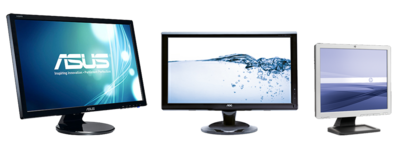Difference between revisions of "User:Hungry eyes/Sandbox/Guide: Purchasing a Monitor"
Hungry eyes (talk | contribs) |
Hungry eyes (talk | contribs) |
||
| Line 32: | Line 32: | ||
===User Reviews=== | ===User Reviews=== | ||
==Other Jargon== | ==Other Jargon== | ||
| − | ==References | + | ==Useful Links== |
| + | =References= | ||
<references /> | <references /> | ||
Revision as of 07:48, 19 June 2012
Choosing the right monitor is one of the most important decisions made during the process of building or upgrading a gaming rig. A standalone monitor is not only essential for a desktop computer, but can also vastly improve the gaming experience when using a notebook or other portable device. What follows is intended to be a comprehensive guide to purchasing a new computer monitor, covering all aspects of selection, from technical specifications, to pricing and both user and professional reviews.
Things to Avoid
Before beginning the process of selecting your new computer monitor, there are a number of things you should first ensure you avoid.
- Picking by brand - When purchasing a monitor, or any computer component, it is very easy to focus on the branding, casting aside important price or technical considerations, with the possibility of ending up with an expensive and poor quality product as a result. If you have found a company's products of a high quality in the past, it is important to take this into consideration, but it is also vital that you research all available alternatives thoroughly to ensure the greatest value for money. Desirable brands will often come with a substantial price premium, and this should not be overlooked.
- Obsessing over user reviews - User reviews can be a useful tool in judging the quality of a product, but they tend to polarise opinion, and it is important to examine them with a cautious eye. If in doubt about a product, its often best to look at the 3-star reviews rather than the 1 or 5 star, as these tend to be more balanced and informative. If a product has just one or two reviews, they may not be particularly useful, as it is difficult to build a general picture based upon them, and the user experiences may be very personal to each review.
- Exceeding your budget - When browsing possible options, it is very easy to get carried away with additional features and superior specifications. It is important to set yourself a maximum budget at the start and stick to it, but also to ensure you remain focused on what you require from a monitor for your specific purposes - a monitor with a webcam might not be worth the expense if you don't use video chat often, and a rapid refresh rate may not be important if you only plan to use your monitor to play Minecraft and browse the web.
- Buying too big - It may be best to first measure out the area you have available for your new monitor before considering your options - it is all too easy to purchase a monitor too large for your desk or table.

